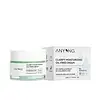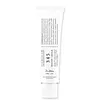What's inside
What's inside
 Key Ingredients
Key Ingredients

 Benefits
Benefits

 Concerns
Concerns

 Ingredients Side-by-side
Ingredients Side-by-side

Water
Skin ConditioningCentella Asiatica Leaf Extract
Skin ConditioningBacillus
Skin ConditioningNiacinamide
SmoothingSodium Hyaluronate
HumectantCapryloyl Salicylic Acid
ExfoliatingButylene Glycol
HumectantPropylene Glycol
HumectantAloe Barbadensis Leaf Juice
Skin ConditioningEctoin
Skin ConditioningGlycerin
HumectantSalix Alba Bark Extract
AstringentGinkgo Biloba Leaf Extract
Skin ConditioningInulin
Skin ConditioningFructose
HumectantAllantoin
Skin ConditioningMadecassic Acid
Skin ConditioningAsiaticoside
AntioxidantAsiatic Acid
Skin ConditioningPanthenol
Skin ConditioningSodium PCA
HumectantSorbitol
HumectantSpirulina Platensis Extract
Skin ProtectingPotassium Sorbate
PreservativeAcrylates/C10-30 Alkyl Acrylate Crosspolymer
Emulsion Stabilising1,2-Hexanediol
Skin ConditioningCaprylyl Glycol
EmollientPentylene Glycol
Skin ConditioningEthylhexylglycerin
Skin ConditioningWater, Centella Asiatica Leaf Extract, Bacillus, Niacinamide, Sodium Hyaluronate, Capryloyl Salicylic Acid, Butylene Glycol, Propylene Glycol, Aloe Barbadensis Leaf Juice, Ectoin, Glycerin, Salix Alba Bark Extract, Ginkgo Biloba Leaf Extract, Inulin, Fructose, Allantoin, Madecassic Acid, Asiaticoside, Asiatic Acid, Panthenol, Sodium PCA, Sorbitol, Spirulina Platensis Extract, Potassium Sorbate, Acrylates/C10-30 Alkyl Acrylate Crosspolymer, 1,2-Hexanediol, Caprylyl Glycol, Pentylene Glycol, Ethylhexylglycerin
Water
Skin ConditioningPropanediol
SolventGlycerin
HumectantCyclohexasiloxane
Emollient1,2-Hexanediol
Skin ConditioningNiacinamide
SmoothingCaprylic/Capric Triglyceride
MaskingPolyglycerin-3
HumectantPanthenol
Skin ConditioningPolyglyceryl-10 Stearate
Skin ConditioningHydrogenated Polydecene
EmollientHydrogenated Poly(C6-14 Olefin)
EmollientDicaprylyl Carbonate
EmollientAmmonium Acryloyldimethyltaurate/Vp Copolymer
C14-22 Alcohols
Emulsion StabilisingPolymethylsilsesquioxane
C12-20 Alkyl Glucoside
EmulsifyingButylene Glycol
HumectantAcrylates/C10-30 Alkyl Acrylate Crosspolymer
Emulsion StabilisingEthylhexylglycerin
Skin ConditioningPolyquaternium-51
Skin ConditioningTromethamine
BufferingSodium Hyaluronate
HumectantCoptis Japonica Root Extract
Skin ConditioningHouttuynia Cordata Extract
Skin ConditioningOenothera Biennis Flower Extract
AstringentBeta-Glucan
Skin ConditioningResveratrol
AntioxidantGardenia Florida Fruit Extract
Skin ConditioningLavandula Angustifolia Flower Extract
CleansingOpuntia Ficus-Indica Stem Extract
Skin ConditioningHydrolyzed Hyaluronic Acid
HumectantCentella Asiatica Leaf Extract
Skin ConditioningPhenoxyethanol
PreservativeHibiscus Sabdariffa Flower Extract
Skin ConditioningTocopherol
AntioxidantCorallina Officinalis Extract
Skin ConditioningCeramide NP
Skin ConditioningWater, Propanediol, Glycerin, Cyclohexasiloxane, 1,2-Hexanediol, Niacinamide, Caprylic/Capric Triglyceride, Polyglycerin-3, Panthenol, Polyglyceryl-10 Stearate, Hydrogenated Polydecene, Hydrogenated Poly(C6-14 Olefin), Dicaprylyl Carbonate, Ammonium Acryloyldimethyltaurate/Vp Copolymer, C14-22 Alcohols, Polymethylsilsesquioxane, C12-20 Alkyl Glucoside, Butylene Glycol, Acrylates/C10-30 Alkyl Acrylate Crosspolymer, Ethylhexylglycerin, Polyquaternium-51, Tromethamine, Sodium Hyaluronate, Coptis Japonica Root Extract, Houttuynia Cordata Extract, Oenothera Biennis Flower Extract, Beta-Glucan, Resveratrol, Gardenia Florida Fruit Extract, Lavandula Angustifolia Flower Extract, Opuntia Ficus-Indica Stem Extract, Hydrolyzed Hyaluronic Acid, Centella Asiatica Leaf Extract, Phenoxyethanol, Hibiscus Sabdariffa Flower Extract, Tocopherol, Corallina Officinalis Extract, Ceramide NP
 Reviews
Reviews

Ingredients Explained
These ingredients are found in both products.
Ingredients higher up in an ingredient list are typically present in a larger amount.
1,2-Hexanediol is a synthetic liquid and another multi-functional powerhouse.
It is a:
- Humectant, drawing moisture into the skin
- Emollient, helping to soften skin
- Solvent, dispersing and stabilizing formulas
- Preservative booster, enhancing the antimicrobial activity of other preservatives
Acrylates/C10-30 Alkyl Acrylate Crosspolymer is a synthetic polymer. It is used to thicken and improve the texture of products. Due to its properties, it can prevent water and oil ingredients from separating.
Butylene Glycol (or BG) is used within cosmetic products for a few different reasons:
Overall, Butylene Glycol is a safe and well-rounded ingredient that works well with other ingredients.
Though this ingredient works well with most skin types, some people with sensitive skin may experience a reaction such as allergic rashes, closed comedones, or itchiness.
Learn more about Butylene GlycolCentella Asiatica Leaf Extract comes from the leaves of an herb plant native to Southeast Asia. Centella Asiatica is rich in antioxidants and amino acids. It can help reduce irritation and soothe the skin.
Many active components found in centella asiatica, such as Madecassic Acid and Asiaticoside, encourage the skin to naturally produce hyaluronic acid. This helps keep our skin hydrated. Many of these components also show antioxidant activity and may help reduce the signs of aging.
Research shows centella asiatica can help increase Type I collagen production by increasing fibroblast production. Fibroblast helps form connective tissue.
The combination of all these properties makes centella asiatica leaf extract effective at soothing the skin.
Other components of centella asiatica leaf extract include Vitamin A, vitamin C, several B vitamins, and Asiatic Acid.
Recent studies found madecassoside may help prevent damage from UV rays by preventing UV-induced inflammation. Further research is needed.
This plant has been used as a medicine and in food for many centuries. As a medicine, it is used to treat burns, scratches, and wounds.
Learn more about Centella Asiatica Leaf ExtractEthylhexylglycerin (we can't pronounce this either) is commonly used as a preservative and skin softener. It is derived from glyceryl.
You might see Ethylhexylglycerin often paired with other preservatives such as phenoxyethanol. Ethylhexylglycerin has been found to increase the effectiveness of these other preservatives.
Glycerin is already naturally found in your skin. It helps moisturize and protect your skin.
A study from 2016 found glycerin to be more effective as a humectant than AHAs and hyaluronic acid.
As a humectant, it helps the skin stay hydrated by pulling moisture to your skin. The low molecular weight of glycerin allows it to pull moisture into the deeper layers of your skin.
Hydrated skin improves your skin barrier; Your skin barrier helps protect against irritants and bacteria.
Glycerin has also been found to have antimicrobial and antiviral properties. Due to these properties, glycerin is often used in wound and burn treatments.
In cosmetics, glycerin is usually derived from plants such as soybean or palm. However, it can also be sourced from animals, such as tallow or animal fat.
This ingredient is organic, colorless, odorless, and non-toxic.
Glycerin is the name for this ingredient in American English. British English uses Glycerol/Glycerine.
Learn more about GlycerinNiacinamide is a multitasking form of vitamin B3 that strengthens the skin barrier, reduces pores and dark spots, regulates oil, and improves signs of aging.
And the best part? It's gentle and well-tolerated by most skin types, including sensitive and reactive skin.
You might have heard of "niacin flush", or the reddening of skin that causes itchiness. Niacinamide has not been found to cause this.
In very rare cases, some individuals may not be able to tolerate niacinamide at all or experience an allergic reaction to it.
If you are experiencing flaking, irritation, and dryness with this ingredient, be sure to double check all your products as this ingredient can be found in all categories of skincare.
When incorporating niacinamide into your routine, look out for concentration amounts. Typically, 5% niacinamide provides benefits such as fading dark spots. However, if you have sensitive skin, it is better to begin with a smaller concentration.
When you apply niacinamide to your skin, your body converts it into nicotinamide adenine dinucleotide (NAD). NAD is an essential coenzyme that is already found in your cells as "fuel" and powers countless biological processes.
In your skin, NAD helps repair cell damage, produce new healthy cells, support collagen production, strengthen the skin barrier, and fight environmental stressors (like UV and pollution).
Our natural NAD levels start to decline with age, leading to slower skin repair, visible aging, and a weaker skin barrier. By providing your skin niacinamide, you're recharging your skin's NAD levels. This leads to stronger, healthier, and younger looking skin.
Another name for vitamin B3 is nicotinamide. This vitamin is water-soluble and our bodies don't store it. We obtain Vitamin B3 from either food or skincare. Meat, fish, wheat, yeast, and leafy greens contain vitamin B3.
The type of niacinamide used in skincare is synthetically created.
Learn more about NiacinamidePanthenol is a common ingredient that helps hydrate and soothe the skin. It is found naturally in our skin and hair.
There are two forms of panthenol: D and L.
D-panthenol is also known as dexpanthenol. Most cosmetics use dexpanthenol or a mixture of D and L-panthenol.
Panthenol is famous due to its ability to go deeper into the skin's layers. Using this ingredient has numerous pros (and no cons):
Like hyaluronic acid, panthenol is a humectant. Humectants are able to bind and hold large amounts of water to keep skin hydrated.
This ingredient works well for wound healing. It works by increasing tissue in the wound and helps close open wounds.
Once oxidized, panthenol converts to pantothenic acid. Panthothenic acid is found in all living cells.
This ingredient is also referred to as pro-vitamin B5.
Learn more about PanthenolSodium Hyaluronate is hyaluronic acid's salt form. It is commonly derived from the sodium salt of hyaluronic acid.
Like hyaluronic acid, it is great at holding water and acts as a humectant. This makes it a great skin hydrating ingredient.
Sodium Hyaluronate is naturally occurring in our bodies and is mostly found in eye fluid and joints.
These are some other common types of Hyaluronic Acid:
Learn more about Sodium HyaluronateWater. It's the most common cosmetic ingredient of all. You'll usually see it at the top of ingredient lists, meaning that it makes up the largest part of the product.
So why is it so popular? Water most often acts as a solvent - this means that it helps dissolve other ingredients into the formulation.
You'll also recognize water as that liquid we all need to stay alive. If you see this, drink a glass of water. Stay hydrated!
Learn more about Water